Revealing the Intellectual Structure and Evolution of Digital Addiction Research: An Integrated Bibliometric and Science Mapping Approach
Abstract
1. Introduction
1.1. Digital Addiction
1.2. The Purpose of the Study
2. Materials and Methods
2.1. Study Design
2.2. Data Search and Identification
TITLE (“digital addiction” OR “internet addiction” OR “social media addiction” OR “smartphone addiction” OR “mobile phone addiction” OR “digital media addiction” OR “game addiction” OR “virtual addiction” OR “technology addiction” OR “computer game addiction” OR “gaming addiction” OR “mobile addiction” OR “online shopping addiction” OR “cybersex addiction” OR “gadget addiction” OR “mobile apps addiction” OR “sms addiction” OR “selfie addiction”)
2.3. Data Extraction and Analysis
3. Results
3.1. Overall Bibliometric Analysis
3.1.1. Publication Trends
3.1.2. Most Influential Authors
3.1.3. Most Influential Journals
3.1.4. Most Cited Articles
3.1.5. Most Productive Countries
3.2. Science Mapping and Performance Analysis
3.2.1. Scientific Evolution Structure
Period 1 (1997–2012)
Period 2 (2013–2017)
Period 3 (2018–2022)
3.2.2. Overlapping Map
3.2.3. Thematic Evolution Structure
4. Discussion
5. Conclusions
Author Contributions
Funding
Institutional Review Board Statement
Informed Consent Statement
Data Availability Statement
Conflicts of Interest
References
- Hoehe, M.R.; Thibaut, F. Going Digital: How Technology Use May Influence Human Brains and Behavior. Dialogues Clin. Neurosci. 2022, 22, 93–97. [Google Scholar] [CrossRef] [PubMed]
- Urbach, N.; Röglinger, M. Introduction to Digitalization Cases: How Organizations Rethink their Business for the Digital Age. In Digitalization Cases: How Organizations Rethink Their Business for the Digital Age; Urbach, N., Röglinger, M., Eds.; Springer: Cham, Denmark, 2019; pp. 1–12. [Google Scholar] [CrossRef]
- Egard, H.; Hansson, K. The Digital Society Comes Sneaking in. An Emerging Field and Its Disabling Barriers. Disabil. Soc. 2021. [Google Scholar] [CrossRef]
- Rugai, J.; Hamiliton-Ekeke, J.-T. A Review of Digital Addiction: A Call for Safety Education. Educ. e-Learn. Res. 2016, 3, 17–22. [Google Scholar]
- Allcott, H.; Gentzkow, M.; Song, L. Digital Addiction. Am. Econ. Rev. 2022, 112, 2424–2463. [Google Scholar] [CrossRef]
- Singh, A.K.; Singh, P.K. Digital Addiction: A Conceptual Overview. Libr. Philos. Pract. 2019, p. 3538. Available online: https://digitalcommons.unl.edu/libphilprac/3538?utm_source=digitalcommons.unl.edu%2Flibphilprac%2F3538&utm_medium=PDF&utm_campaign=PDFCoverPages (accessed on 2 August 2022).
- Alter, A. Irresistible: The Rise of Addictive Technology and the Business of Keeping Us Hooked; Penguin Books: New York, NY, USA, 2018; ISBN 9780698402638. [Google Scholar]
- Christakis, D.A. The Challenges of Defining and Studying “Digital Addiction” in Children. JAMA 2019, 321, 2277–2278. [Google Scholar] [CrossRef]
- Dresp-Langley, B.; Hutt, A. Digital Addiction and Sleep. Int. J. Environ. Res. Public Health 2022, 19, 6910. [Google Scholar] [CrossRef]
- Meng, S.-Q.; Cheng, J.-L.; Li, Y.-Y.; Yang, X.-Q.; Zheng, J.-W.; Chang, X.-W.; Shi, Y.; Chen, Y.; Lu, L.; Sun, Y.; et al. Global Prevalence of Digital Addiction in General Population: A Systematic Review and Meta-analysis. Clin. Psychol. Rev. 2022, 92, 102128. [Google Scholar] [CrossRef]
- Lopez-Fernandez, O. Generalised versus Specific Internet Use-Related Addiction Problems: A Mixed Methods Study on Internet, Gaming, and Social Networking Behaviours. Int. J. Environ. Res. Public Health 2018, 15, 2913. [Google Scholar] [CrossRef] [PubMed]
- Basel, A.M.; McAlaney, J.; Skinner, T.; Pleva, M.; Ali, R. Defining Digital Addiction: Key Features from the Literature. Psihologija 2020, 53, 237–253. [Google Scholar] [CrossRef]
- Al-Khani, A.M.; Saquib, J.; Rajab, A.M.; Khalifa, M.A.; Almazrou, A.; Saquib, N. Internet Addiction in Gulf Countries: A Systematic Review and Meta-analysis. J. Behav. Addict. 2021, 10, 601–610. [Google Scholar] [CrossRef]
- Karakose, T.; Polat, H.; Papadakis, S. Examining Teachers’ Perspectives on School Principals’ Digital Leadership Roles and Technology Capabilities during the COVID-19 Pandemic. Sustainability 2021, 13, 13448. [Google Scholar] [CrossRef]
- Bernheim, B.D.; Rangel, A. Addiction and Cue-Triggered Decision Processes. Am. Econ. Rev. 2004, 94, 1558–1590. [Google Scholar] [CrossRef]
- World Health Organization. Addictive Behaviours: Gaming Disorder. Available online: https://www.who.int/features/qa/gaming-disorder/en/ (accessed on 22 October 2022).
- Király, O.; Potenza, M.N.; Stein, D.J.; King, D.L.; Hodgins, D.C.; Saunders, J.B.; Griffiths, M.D.; Gjoneska, B.; Billieux, J.; Brand, M.; et al. Preventing Problematic Internet Use during the COVID-19 Pandemic: Consensus Guidance. Compr. Psychiatry 2020, 100, 152180. [Google Scholar] [CrossRef]
- Jain, A.; Sharma, R.; Gaur, K.L.; Yadav, N.; Sharma, P.; Sharma, N.; Khan, N.; Kumawat, P.; Jain, G.; Maanju, M.; et al. Study of Internet Addiction and Its Association with Depression and Insomnia in University Students. J. Fam. Med. Prim. Care 2020, 9, 1700–1706. [Google Scholar] [CrossRef]
- Kandasamy, S.; Abdulrahuman, M.B.; Shyamala, J. A Study on Anxiety Disorder Among College Students with Internet Addiction. Int. J. Community Med. Public Health 2019, 6, 1695–1700. [Google Scholar] [CrossRef]
- Hinojo-Lucena, F.-J.; Aznar-Díaz, I.; Cáceres-Reche, M.-P.; Trujillo-Torres, J.-M.; Romero-Rodríguez, J.-M. Problematic Internet Use as a Predictor of Eating Disorders in Students: A Systematic Review and Meta-Analysis Study. Nutrients 2019, 11, 2151. [Google Scholar] [CrossRef]
- Raouf, S.Y.A.; Gabr, H.M.; Al-Wutayd, O.; Al-Batanony, M.A. Video Game Disorder and Mental Wellbeing among University Students: A Cross-Sectional Study. Pan Afr. Med. J. 2022, 41, 89. [Google Scholar] [CrossRef]
- Kuss, D.J.; Griffiths, M.D.; Karila, L.; Billieux, J. Internet Addiction: A Systematic Review of Epidemiological Research for the Last Decade. Curr. Pharm. Des. 2014, 20, 4026–4052. [Google Scholar] [CrossRef]
- Shaw, M.; Black, D.W. Internet Addiction: Definition, Assessment, Epidemiology and Clinical Management. CNS Drugs 2008, 22, 353–365. [Google Scholar] [CrossRef]
- Alrobai, A.; McAlaney, J.; Phalp, K.; Ali, R. Exploring the Risk Factors of Interactive E-Health Interventions for Digital Addiction. Int. J. Sociotechnol. Knowl. Dev. 2016, 8, 1. [Google Scholar] [CrossRef]
- Ha, J.-H.; Yoo, H.-J.; Cho, I.-H.; Chin, B.; Shin, D.; Kim, J.-H. Psychiatric Comorbidity Assessed in Korean Children and Adolescents Who Screen Positive for Internet Addiction. J. Clin. Psychiatry 2006, 67, 821–826. [Google Scholar] [CrossRef] [PubMed]
- Cobo, M.J.; López-Herrera, A.G.; Herrera-Viedma, E.; Herrera, F. Science Mapping Software Tools: Review, Analysis, and Cooperative Study Among Tools. J. Assoc. Inf. Sci. Technol. 2011, 62, 1382–1402. [Google Scholar] [CrossRef]
- MacFadden, I.; Santana, M.; Vázquez-Cano, E.; López-Meneses, E. A Science Mapping Analysis of ‘Marginality, Stigmatization and Social Cohesion’ in WoS (1963–2019). Qual. Quant. 2021, 55, 275–293. [Google Scholar] [CrossRef]
- Cañadas, D.C.; Perales, A.B.; Belmonte, M.D.P.C.; Martínez, R.G.; Carreño, T.P. Kangaroo Mother Care and Skin-to-Skin Care in Preterm Infants in the Neonatal Intensive Care Unit: A Bibliometric Analysis. Arch. Pédiatrie 2021, 29, 90–99. [Google Scholar] [CrossRef] [PubMed]
- Mongeon, P.; Paul-Hus, A. The Journal Coverage of Web of Science and Scopus: A Comparative Analysis. Scientometrics 2016, 106, 213–228. [Google Scholar] [CrossRef]
- Hallinger, P.; Kulophas, D. The Evolving Knowledge Base on Leadership and Teacher Professional Learning: A Bibliometric Analysis of the Literature, 1960–2018. Prof. Dev. Educ. 2019, 46, 521–540. [Google Scholar] [CrossRef]
- Moher, D.; Liberati, A.; Tetzlaff, J.; Altman, D.G.; PRISMA Group. Preferred Reporting Items for Systematic Reviews and Meta-Analyses: The PRISMA Statement. Ann. Intern. Med. 2009, 151, 264–269. [Google Scholar] [CrossRef]
- Cobo, M.J.; López-Herrera, A.G.; Herrera-Viedma, E.; Herrera, F. SciMAT: A New Science Mapping Analysis Software Tool. J. Assoc. Inf. Sci. Technol. 2012, 63, 1609–1630. [Google Scholar] [CrossRef]
- López-Robles, J.R.; Cobo, M.J.; Gutiérrez-Salcedo, M.; Martínez-Sánchez, M.A.; Gamboa-Rosales, N.K.; Herrera-Viedma, E. 30th Anniversary of Applied Intelligence: A Combination of Bibliometrics and Thematic Analysis Using SciMAT. Appl. Intell. 2021, 51, 6547–6568. [Google Scholar] [CrossRef]
- Zupic, I.; Čater, T. Bibliometric Methods in Management and Organization. Organ. Res. Methods 2015, 18, 429–472. [Google Scholar] [CrossRef]
- Martínez, M.A.; Cobo, M.J.; Herrera, M.; Herrera-Viedma, E. Analyzing the Scientific Evolution of Social Work Using Science Mapping. Res. Soc. Work Pract. 2015, 25, 257–277. [Google Scholar] [CrossRef]
- Batagelj, V.; Cerinšek, M. On Bibliographic Networks. Scientometrics 2013, 96, 845–864. [Google Scholar] [CrossRef]
- Chen, C. Science Mapping: A Systematic Review of the Literature. J. Data Inf. Sci. 2017, 2, 1–40. [Google Scholar] [CrossRef]
- Garfield, E. Scientography: Mapping the Tracks of Science. Curr. Contents: Soc. Behav. Sci. 1994, 7, 5–10. [Google Scholar]
- Callon, M.; Courtial, J.P.; Laville, F. Co-word Analysis as a Tool for Describing the Network of Interactions between Basic and Technological Research: The Case of Polymer Chemistry. Scientometrics 1991, 22, 155–205. [Google Scholar] [CrossRef]
- Coulter, N.; Monarch, I.; Konda, S. Software Engineering as Seen Through Its Research Literature: A Study in Co-word Analysis. J. Am. Soc. Inf. Sci. Technol. 1998, 49, 1206–1223. [Google Scholar] [CrossRef]
- Murgado-Armenteros, E.M.; Gutiérrez-Salcedo, M.; Torres-Ruiz, F.J.; Cobo, M.J. Analysing the Conceptual Evolution of Qualitative Marketing Research through Science Mapping Analysis. Scientometrics 2015, 102, 519–557. [Google Scholar] [CrossRef]
- Börner, K.; Chen, C.; Boyack, K.W. Visualizing Knowledge Domains. In Annual Review of Information Science & Technology; Cronin, B., Ed.; Information Today, Inc./American Society for Information Science and Technology: Medford, NJ, USA, 2005; Volume 37, pp. 179–255, ISBN-13: 978-0938734550. [Google Scholar]
- Sternitzke, C.; Bergmann, I. Similarity Measures for Document Mapping: A Comparative Study on the Level of an Individual Scientist. Scientometrics 2009, 78, 113–130. [Google Scholar] [CrossRef]
- Alonso, S.; Cabrerizo, F.J.; Herrera-Viedma, E.; Herrera, F. H-Index: A Review Focused in Its Variants, Computation and Standardization for Different Scientific Fields. J. Informetr. 2009, 3, 273–289. [Google Scholar] [CrossRef]
- Hirsch, J.E. An Index to Quantify an Individual’s Scientific Research Output. Proc. Natl. Acad. Sci. USA 2005, 102, 16569–16572. [Google Scholar] [CrossRef]
- Jeong, E.J.; Kim, D.H. Social Activities, Self-Efficacy, Game Attitudes, and Game Addiction. Cyberpsychology Behav. Soc. Netw. 2011, 14, 213–221. [Google Scholar] [CrossRef] [PubMed]
- Iskender, M.; Akin, A. Self-compassion and Internet addiction. Turk. Online J. Educ. Technol. 2011, 10, 215–221. [Google Scholar]
- Isiklar, A. Examination of the Variables Predicting Internet Addiction in Adolescence. Energy Educ. Sci. Tech. 2012, 4, 1417–1424. [Google Scholar]
- Mehroof, M.; Griffiths, M.D. Online Gaming Addiction: The Role of Sensation Seeking, Self-Control, Neuroticism, Aggression, State Anxiety, and Trait Anxiety. Cyberpsychology Behav. Soc. Netw. 2010, 13, 313–316. [Google Scholar] [CrossRef] [PubMed]
- Hsiao, H.-C.; Chung, H.-N.; Tu, Y.-L. A Study on Internet Addiction, College Students’ Personal Characteristics Issues and Cyber Behaviors. Int. J. Learn. 2010, 17, 285–294. [Google Scholar] [CrossRef]
- Tsai, C.-C.; Lin, S.S.J. Analysis of Attitudes toward Computer Networks and Internet Addiction of Taiwanese Adolescents. Cyberpsychology Behav. 2001, 4, 373–376. [Google Scholar] [CrossRef]
- Guo, J.; Chen, L.; Wang, X.; Liu, Y.; Chui, C.H.K.; He, H.; Qu, Z.; Tian, D. The Relationship Between Internet Addiction and Depression among Migrant Children and Left-Behind Children in China. Cyberpsychology Behav. Soc. Netw. 2012, 15, 585–590. [Google Scholar] [CrossRef]
- Ko, C.-H.; Yen, J.-Y.; Yen, C.-F.; Chen, C.-S.; Wang, S.-Y. The Association between Internet Addiction and Belief of Frustration Intolerance: The Gender Difference. Cyberpsychology Behav. 2008, 11, 273–278. [Google Scholar] [CrossRef]
- Lam, L.T.; Peng, Z.-W.; Mai, J.-C.; Jing, J. Factors Associated with Internet Addiction among Adolescents. Cyberpsychology Behav. 2009, 12, 551–555. [Google Scholar] [CrossRef]
- Yen, J.-Y.; Yen, C.-F.; Wu, H.-Y.; Huang, C.-J.; Ko, C.-H. Hostility in the Real World and Online: The Effect of Internet Addiction, Depression, and Online Activity. Cyberpsychology Behav. Soc. Netw. 2011, 14, 649–655. [Google Scholar] [CrossRef]
- Xiuqin, H.; Huimin, Z.; Mengchen, L.; Jinan, W.; Ying, Z.; Ran, T. Mental Health, Personality, and Parental Rearing Styles of Adolescents with Internet Addiction Disorder. Cyberpsychology Behav. Soc. Netw. 2010, 13, 401–406. [Google Scholar] [CrossRef] [PubMed]
- Lin, M.-P.; Ko, H.-C.; Wu, J.Y.-W. Prevalence and Psychosocial Risk Factors Associated with Internet Addiction in a Nationally Representative Sample of College Students in Taiwan. Cyberpsychology Behav. Soc. Netw. 2011, 14, 741–746. [Google Scholar] [CrossRef] [PubMed]
- Canan, F.; Ataoglu, A.; Nichols, L.A.; Yildirim, T.; Ozturk, O. Evaluation of Psychometric Properties of the Internet Addiction Scale in a Sample of Turkish High School Students. Cyberpsychology Behav. Soc. Netw. 2010, 13, 317–320. [Google Scholar] [CrossRef] [PubMed]
- Fioravanti, G.; Dèttore, D.; Casale, S. Adolescent Internet Addiction: Testing the Association between Self-Esteem, the Perception of Internet Attributes, and Preference for Online Social Interactions. Cyberpsychology Behav. Soc. Netw. 2012, 15, 318–323. [Google Scholar] [CrossRef]
- Skoric, M.M.; Teo, L.L.C.; Neo, R.L. Children and Video Games: Addiction, Engagement, and Scholastic Achievement. Cyberpsychology Behav. 2009, 12, 567–572. [Google Scholar] [CrossRef]
- Hur, M.H. Demographic, Habitual, and Socioeconomic Determinants of Internet Addiction Disorder: An Empirical Study of Korean Teenagers. Cyberpsychology Behav. 2006, 9, 514–525. [Google Scholar] [CrossRef]
- Floros, G.; Siomos, K.; Stogiannidou, A.; Giouzepas, I.; Garyfallos, G. The Relationship between Personality, Defense Styles, Internet Addiction Disorder, and Psychopathology in College Students. Cyberpsychology Behav. Soc. Netw. 2014, 17, 672–676. [Google Scholar] [CrossRef]
- Zhou, S.X.; Leung, L. Gratification, Loneliness, Leisure Boredom, and Self-Esteem as Predictors of SNS-Game Addiction and Usage Pattern among Chinese College Students. Cyberpsychology Behav. Soc. Psychol. Learn 2012, 2, 34–48. [Google Scholar] [CrossRef]
- Akın, A. The Relationships between Internet Addiction, Subjective Vitality, and Subjective Happiness. Cyberpsychology Behav. Soc. Netw. 2012, 15, 404–410. [Google Scholar] [CrossRef]
- Ko, C.-H.; Yen, J.-Y.; Yen, C.-F.; Lin, H.-C.; Yang, M.J. Factors Predictive for Incidence and Remission of Internet Addiction in Young Adolescents: A Prospective Study. Cyberpsychology Behav. 2007, 10, 545–551. [Google Scholar] [CrossRef]
- De Berardis, D.; D’Albenzio, A.; Gambi, F.; Sepede, G.; Valchera, A.; Conti, C.M.; Fulcheri, M.; Cavuto, M.; Ortolani, C.; Salerno, R.M.; et al. Alexithymia and Its Relationships with Dissociative Experiences and Internet Addiction in a Nonclinical Sample. Cyberpsychology Behav. 2009, 12, 67–69. [Google Scholar] [CrossRef] [PubMed]
- Lemmens, J.S.; Valkenburg, P.M.; Peter, J. Development and Validation of a Game Addiction Scale for Adolescents. Media Psychol. 2009, 12, 77–95. [Google Scholar] [CrossRef]
- Wan, C.-S.; Chiou, W.-B. Psychological Motives and Online Games Addiction: A Test of Flow Theory and Humanistic Needs Theory for Taiwanese Adolescents. Cyberpsychology Behav. 2006, 9, 317–324. [Google Scholar] [CrossRef] [PubMed]
- Ak, Ş.; Koruklu, N.; Yılmaz, Y.A. Study on Turkish Adolescent’s Internet Use: Possible Predictors of Internet Addiction. Cyberpsychology Behav. Soc. Netw. 2013, 16, 205–209. [Google Scholar] [CrossRef] [PubMed]
- Chi, X.; Lin, L.; Zhang, P. Internet Addiction Among College Students in China: Prevalence and Psychosocial Correlates. Cyberpsychology Behav. Soc. Netw. 2016, 19, 567–573. [Google Scholar] [CrossRef]
- Hawi, N.S.; Samaha, M. The Relations among Social Media Addiction, Self-Esteem, and Life Satisfaction in University Students. Soc. Sci. Comput. Rev. 2017, 35, 576–586. [Google Scholar] [CrossRef]
- Tsimtsiou, Z.; Haidich, A.B.; Spachos, D.; Kokkali, S.; Bamidis, P.; Dardavesis, T.; Arvanitidou, M. Internet Addiction in Greek Medical Students: An Online Survey. Acad. Psychiatry 2015, 39, 300–304. [Google Scholar] [CrossRef]
- Brunborg, G.S.; Hanss, D.; Mentzoni, R.A.; Pallesen, S. Core and Peripheral Criteria of Video Game Addiction in the Game Addiction Scale for Adolescents. Cyberpsychology Behav. Soc. Netw. 2015, 18, 280–285. [Google Scholar] [CrossRef]
- Cheng, C.; Sun, P.; Mak, K.K. Internet Addiction and Psychosocial Maladjustment: Avoidant Coping and Coping Inflexibility as Psychological Mechanisms. Cyberpsychology Behav. Soc. Netw. 2015, 18, 539–546. [Google Scholar] [CrossRef]
- Rehbein, F.; Baier, D. Family-, Media-, and School-Related Risk Factors of Video Game Addiction: A 5-Year Longitudinal Study. J. Media Psychol. 2013, 25, 118–128. [Google Scholar] [CrossRef]
- Lau, J.T.; Gross, D.L.; Wu, A.; Cheng, K.-M.; Lau, M. Incidence and Predictive Factors of Internet Addiction among Chinese Secondary School Students in Hong Kong: A Longitudinal Study. Curr. Pharm. Des. 2017, 52, 657–667. [Google Scholar] [CrossRef] [PubMed]
- Lim, J.-A.; Gwak, A.R.; Park, S.M.; Kwon, J.-G.; Lee, J.-Y.; Jung, H.Y.; Sohn, B.K.; Kim, J.W.; Kim, D.J.; Choi, J.S. Are Adolescents with Internet Addiction Prone to Aggressive Behavior? The Mediating Effect of Clinical Comorbidities on the Predictability of Aggression in Adolescents with Internet Addiction. Cyberpsychology Behav. Soc. Netw. 2015, 18, 260–267. [Google Scholar] [CrossRef] [PubMed]
- Berner, J.E.; Santander, J.; Contreras, A.M.; Gómez, T. Description of Internet Addiction Among Chilean Medical Students: A Cross-Sectional Study. Acad. Psychiatry 2014, 38, 11–14. [Google Scholar] [CrossRef]
- Yao, M.Z.; He, J.; Ko, D.M.; Pang, K. The Influence of Personality, Parental Behaviors, and Self-Esteem on Internet Addiction: A Study of Chinese College Students. Cyberpsychology Behav. Soc. Netw. 2014, 17, 104–110. [Google Scholar] [CrossRef] [PubMed]
- You, S.; Kim, E.; Lee, D. Virtually Real: Exploring Avatar Identification in Game Addiction Among Massively Multiplayer Online Role-Playing Games (MMORPG) Players. Games Cult. 2017, 12, 56–71. [Google Scholar] [CrossRef]
- Irles, D.L.; Gomis, R.M. Impulsiveness and Video Game Addiction. Salud Drog. 2016, 16, 33–40. [Google Scholar]
- Bian, M.; Leung, L. Linking Loneliness, Shyness, Smartphone Addiction Symptoms, and Patterns of Smartphone Use to Social Capital. Soc. Sci. Comput. Rev. 2015, 33, 61–79. [Google Scholar] [CrossRef]
- Yang, H.-L.; Wu, W.-P. The Effect of Flow Frequency on Internet Addiction to Different Internet Usage Activities. Int. J. Inf. Commun. 2017, 13, 28–39. [Google Scholar] [CrossRef]
- Dalbudak, E.; Evren, C.; Aldemir, S.; Coskun, K.S.; Ugurlu, H.; Yildirim, F.G. Relationship of Internet Addiction Severity with Depression, Anxiety, and Alexithymia, Temperament and Character in University Students. Cyberpsychology Behav. Soc. Netw. 2013, 16, 272–278. [Google Scholar] [CrossRef]
- Kim, P.W.; Kim, S.Y.; Shim, M.; Im, C.H.; Shon, Y.-M. The Influence of An Educational Course on Language Expression and Treatment of Gaming Addiction for Massive Multiplayer Online Role-Playing Game (MMORPG) Players. Comput. Educ. 2013, 63, 208–217. [Google Scholar] [CrossRef]
- Fioravanti, G.; Casale, S. Evaluation of the Psychometric Properties of the Italian Internet Addiction Test. Cyberpsychology Behav. Soc. Netw. 2015, 18, 120–128. [Google Scholar] [CrossRef] [PubMed]
- Sung, M.; Shin, Y.-M.; Cho, S.-M. Factor Structure of the Internet Addiction Scale and Its Associations with Psychiatric Symptoms for Korean Adolescents. Community Ment. Health J. 2014, 50, 612–618. [Google Scholar] [CrossRef] [PubMed]
- Lai, C.-M.; Mak, K.-K.; Cheng, C.; Watanabe, H.; Nomachi, S.; Bahar, N.; Young, K.S.; Ko, H.-C.; Kim, D.; Griffiths, M.D. Measurement Invariance of the Internet Addiction Test among Hong Kong, Japanese, and Malaysian Adolescents. Cyberpsychology Behav. Soc. Netw. 2015, 18, 609–617. [Google Scholar] [CrossRef] [PubMed]
- Gökçearslan, Ş.; Uluyol, Ç.; Şahin, S. Smartphone Addiction, Cyberloafing, Stress and Social Support among University Students: A Path Analysis. Child. Youth Serv. Rev. 2018, 91, 47–54. [Google Scholar] [CrossRef]
- Zhang, M.W.; Lim, R.B.; Lee, C.; Ho, R. Prevalence of Internet Addiction in Medical Students: A Meta-analysis. Acad. Psychiatry 2018, 42, 88–93. [Google Scholar] [CrossRef]
- Neverkovich, S.D.; Bubnova, I.S.; Kosarenko, N.N.; Sakhieva, R.G.; Sizova, Z.M.; Zakharova, V.L.; Sergeeva, M.G. Students’ Internet Addiction: Study and Prevention. Eurasia J. Math. Sci. Technol. Educ. 2018, 14, 1483–1495. [Google Scholar] [CrossRef]
- Karakose, T. Assessing the Relationships between Internet Addiction, Depression, COVID-19-Related Fear, Anxiety, and Suspicion among Graduate Students in Educational Administration: A Structural Equation Modeling Analysis. Sustainability 2022, 14, 5356. [Google Scholar] [CrossRef]
- Chun, J. Conceptualizing Effective Interventions for Smartphone Addiction Among Korean Female Adolescents. Child. Youth Serv. Rev. 2018, 84, 35–39. [Google Scholar] [CrossRef]
- Arpaci, I.; Kesici, Ş.; Baloğlu, M. Individualism and Internet Addiction: The Mediating Role of Psychological Needs. Internet Res. 2018, 28, 293–314. [Google Scholar] [CrossRef]
- Hawi, N.S.; Samaha, M.; Griffiths, M.D. The Digital Addiction Scale for Children: Development and Validation. Cyberpsychology Behav. Soc. Netw. 2019, 22, 771–778. [Google Scholar] [CrossRef]
- Cheung, T.; Lee, R.L.; Tse, A.C.; Do, C.W.; So, B.C.; Szeto, G.P.; Lee, P.H. Psychometric Properties and Demographic Correlates of the Smartphone Addiction Scale-Short Version Among Chinese Children and Adolescents in Hong Kong. Cyberpsychology Behav. Soc. Netw. 2019, 22, 714–723. [Google Scholar] [CrossRef] [PubMed]
- He, Z.-H.; Li, M.-D.; Ma, X.-Y.; Liu, C.-J. Family Socioeconomic Status and Social Media Addiction in Female College Students: The Mediating Role of Impulsiveness and Inhibitory Control. J. Genet. Psychol. 2021, 182, 60–74. [Google Scholar] [CrossRef]
- Jiang, Q.; Huang, X.; Tao, R. Examining Factors Influencing Internet Addiction and Adolescent Risk Behaviors among Excessive Internet Users. Health Commun. 2018, 33, 1434–1444. [Google Scholar] [CrossRef]
- Huang, Y.; Jung, H.-R.; Lim, C.H. Effects of Smartphone Addiction on Radiology Students’ Interpersonal Satisfaction. Med. Legal. Update 2020, 20, 1971–1975. [Google Scholar] [CrossRef]
- Hasan, A.A.-H.; Jaber, A.A. Prevalence of Internet Addiction, Its Association with Psychological Distress, Coping Strategies Among Undergraduate Students. Nurse Educ. Today 2019, 81, 78–82. [Google Scholar] [CrossRef]
- Soomro, K.A.; Zai, S.A.Y.; Hina, Q.A. Investigating the Impact of University Students’ Smartphone Addiction on their Satisfaction with Classroom Connectedness. Educ. Inf. Technol. 2019, 24, 3523–3535. [Google Scholar] [CrossRef]
- Albursan, I.S.; Al Qudah, M.F.; Dutton, E.; Hassan, E.M.A.H.; Bakhiet, S.F.A.; Alfnan, A.A.; Aljomaa, S.S.; Hammad, H.I. National, Sex and Academic Discipline Difference in Smartphone Addiction: A Study of Students in Jordan, Saudi Arabia, Yemen and Sudan. Community Ment. Health J. 2019, 55, 825–830. [Google Scholar] [CrossRef] [PubMed]
- Nam, C.R.; Lee, D.H.; Lee, J.Y.; Choi, A.R.; Chung, S.J.; Kim, D.-J.; Bhang, S.-Y.; Kwon, J.-G.; Kweon, Y.-S.; Choi, J.-S. The Role of Resilience in Internet Addiction Among Adolescents between Sexes: A Moderated Mediation Model. J. Clin. Med. 2018, 7, 222. [Google Scholar] [CrossRef]
- Mun, I.B.; Lee, S. How Does Parental Smartphone Addiction Affect Adolescent Smartphone Addiction?: Testing the Mediating Roles of Parental Rejection and Adolescent Depression. Cyberpsychology Behav. Soc. Netw. 2021, 24, 399–406. [Google Scholar] [CrossRef]
- Kim, N.; Sung, J.Y.; Park, J.Y.; Kong, I.D.; Hughes, T.L.; Kim, D.-K. Association between Internet Gaming Addiction and Leukocyte Telomere Length in Korean Male Adolescents. Soc. Sci. Med. 2019, 222, 84–90. [Google Scholar] [CrossRef]
- Seok, H.J.; Lee, J.M.; Park, C.-Y.; Park, J.Y. Understanding Internet Gaming Addiction Among South Korean Adolescents through Photovoice. Child. Youth Serv. Rev. 2018, 94, 35–42. [Google Scholar] [CrossRef]
- Miskulin, I.; Simic, I.; Pavlovic, N.; Kovacevic, J.; Fotez, I.; Kondza, G.; Palenkic, H.; Bilic-Kirin, V.; Kristic, M.; Miskulin, M. Personality Traits of Croatian University Students with Internet Addiction. Behav. Sci. 2022, 12, 173. [Google Scholar] [CrossRef]
- Kim, K.; Yee, J.; Chung, J.E.; Kim, H.J.; Han, J.M.; Kim, J.H.; Lee, K.E.; Gwak, H.S. Smartphone Addiction and Anxiety in Adolescents–A Cross-sectional Study. Am. J. Health Behav. 2021, 45, 895–901. [Google Scholar] [CrossRef] [PubMed]
- Rosenthal, S.R.; Cha, Y.; Clark, M.A. The Internet Addiction Test in a Young Adult US Population. Cyberpsychology Behav. Soc. Netw. 2018, 21, 661–666. [Google Scholar] [CrossRef] [PubMed]
- Sun, Y.; Wilkinson, J.S. Parenting Style, Personality Traits, and Interpersonal Relationships: A Model of Prediction of Internet Addiction. Int. J. Commun. 2020, 14, 2163–2185. [Google Scholar]
- Osorio-Molina, C.; Martos-Cabrera, M.B.; Membrive-Jiménez, M.J.; Vargas-Roman, K.; Suleiman-Martos, N.; Ortega-Campos, E.; Gómez-Urquiza, J.L. Smartphone Addiction, Risk Factors and Its Adverse Effects in Nursing Students: A Systematic Review and Meta-analysis. Nurse Educ. Today 2021, 98, 104741. [Google Scholar] [CrossRef]
- Xie, X.; Chen, W.; Zhu, X.; He, D. Parents’ Phubbing Increases Adolescents’ Mobile Phone Addiction: Roles of Parent-Child Attachment, Deviant Peers, and Gender. Child. Youth Serv. Rev. 2019, 105, 104426. [Google Scholar] [CrossRef]
- Erdem, C.; Uzun, A.M. Smartphone Addiction Among Undergraduates: Roles of Personality Traits and Demographic Factors. Technol. Knowl. 2020, 27, 579–597. [Google Scholar] [CrossRef]
- Durak, H.Y. Investigation of Nomophobia and Smartphone Addiction Predictors among Adolescents in Turkey: Demographic Variables and Academic Performance. Soc. Sci. J. 2019, 56, 492–517. [Google Scholar] [CrossRef]
- Anshari, M.; Alas, Y.; Sulaiman, E. Smartphone Addictions and Nomophobia Among Youth. Vulnerable Child. Youth Stud. 2019, 14, 242–247. [Google Scholar] [CrossRef]
- Li, L.; Gao, H.; Xu, Y. The Mediating and Buffering Effect of Academic Self-Efficacy on the Relationship between Smartphone Addiction and Academic Procrastination. Comput. Educ. 2020, 159, 104001. [Google Scholar] [CrossRef]
- Sun, R.; Gao, Q.; Xiang, Y.; Chen, T.; Liu, T.; Chen, Q. Parent–Child Relationships and Mobile Phone Addiction Tendency among Chinese Adolescents: The Mediating Role of Psychological Needs Satisfaction and the Moderating Role of Peer Relationships. Child. Youth Serv. Rev. 2020, 116, 105113. [Google Scholar] [CrossRef]
- Bilgin, O.; Taş, İ. Effects of Perceived Social Support and Psychological Resilience on Social Media Addiction among University Students. Univers. J. Educ. Res. 2018, 6, 751–758. [Google Scholar] [CrossRef]
- Kumar, G.; Dash, P.; Jnaneswar, A.; Suresan, V.; Jha, K.; Ghosal, S. Impact of Internet Addiction during COVID-19 on Anxiety and Sleep Quality among College Students of Bhubaneswar City. J. Educ. Health Promot. 2022, 11, 156. [Google Scholar] [CrossRef] [PubMed]
- Al Shawi, A.F.; Hameed, A.K.; Shalal, A.I.; Abd Kareem, S.S.; Majeed, M.A.; Humidy, S.T. Internet Addiction and Its Relationship to Gender, Depression and Anxiety Among Medical Students in Anbar Governorate-West of Iraq. Community Health Equity Res. Policy 2022, 42, 253–256. [Google Scholar] [CrossRef]
- Yang, X.; Zhou, Z.; Liu, Q.; Fan, C. Mobile Phone Addiction and Adolescents’ Anxiety and Depression: The Moderating Role of Mindfulness. J. Child. Fam. Stud. 2019, 28, 822–830. [Google Scholar] [CrossRef]
- Lee, J.Y.; Ko, D.W.; Lee, H. Loneliness, Regulatory Focus, Inter-Personal Competence, and Online Game Addiction: A Moderated Mediation Model. Internet Res. 2019, 29, 381–394. [Google Scholar] [CrossRef]
- Kil, N.; Kim, J.; McDaniel, J.T.; Kim, J.; Kensinger, K. Examining Associations Between Smartphone Use, Smartphone Addiction, And Mental Health Outcomes: A Cross-Sectional Study of College Students. Health Promot. Perspect. 2021, 11, 36–44. [Google Scholar] [CrossRef]
- Gorjinpour, F.; Tavana, Z. Relationship between Attachment Styles and Internet Addiction and Its Influence on Female High School Students Academic Achievement. J. Health Sci. Surveill. Syst. 2022, 10, 50–55. [Google Scholar]
- Lazarinis, F.; Alexandri, K.; Panagiotakopoulos, C.; Verykios, V.S. Sensitizing Young Children on Internet Addiction and Online Safety Risks through Storytelling in a Mobile Application. Educ. Inf. Technol 2020, 25, 163–174. [Google Scholar] [CrossRef]
- Salazar-Concha, C.; Ficapal-Cusí, P.; Boada-Grau, J.; Camacho, L.J. Analyzing the Evolution of Technostress: A Science Mapping Approach. Heliyon 2021, 7, 06726. [Google Scholar] [CrossRef] [PubMed]
- Young, K.S. Internet Addiction: A New Clinical Phenomenon and Its Consequences. Am. Behav. Sci. 2004, 48, 402–415. [Google Scholar] [CrossRef]
- Montag, C.; Walla, P. Carpe Diem Instead Of Losing Your Social Mind: Beyond Digital Addiction and Why We All Suffer From Digital Overuse. Cogent Psychol. 2016, 3, 1157281. [Google Scholar] [CrossRef]
- Duke, E.; Montag, C. Smartphone Addiction and Beyond: Initial Insights on an Emerging Research Topic and Its Relationship to Internet Addiction. In Internet Addiction: Neuroscientific Approaches and Therapeutical Implications Including Smartphone Addiction, 2nd ed.; Montag, C., Reuter, M., Eds.; Springer International Publishing: Cham, Switzerland, 2017; pp. 359–379. ISBN 978-3-319-46275-2. [Google Scholar]
- Young, K.S.; Yue, X.D.; Ying, L. Prevalence Estimates and Etiologic Models of Internet Addiction. In Internet Addiction: A Handbook and Guide to Evaluation and Treatment; Young, K.S., Abreu, C.N., Eds.; John Wiley & Sons, Inc.: Hoboken, NJ, USA, 2011; pp. 3–18. [Google Scholar] [CrossRef]
- Lin, Y.-H.; Lin, S.-H.; Yang, C.C.H.; Kuo, T.B.J. Psychopathology of Everyday Life in the 21st century: Smartphone Addiction. In Internet Addiction: Neuroscientific Approaches and Therapeutical Implications Including Smartphone Addiction, 2nd ed.; Montag, C., Reuter, M., Eds.; Springer International Publishing: Cham, Switzerland, 2017; pp. 3–18. ISBN 978-3-319-46275-2. [Google Scholar]
- Young, K.S. The Evolution of Internet Addiction Disorder. In Internet Addiction: Neuroscientific Approaches and Therapeutical Implications Including Smartphone Addiction, 2nd ed.; Montag, C., Reuter, M., Eds.; Springer International Publishing: Cham, Switzerland, 2017; pp. 3–18. ISBN 978-3-319-46275-2. [Google Scholar]
- Young, K.S. Internet Addiction: The Emergence of a New Clinical Disorder. Cyberpsychology Behav. 1998, 1, 237–244. [Google Scholar] [CrossRef]
- Kesmodel, U.S. Cross-sectional Studies–What Are They Good For? Acta Obstet. Gynecol. Scand. 2018, 97, 388–393. [Google Scholar] [CrossRef] [PubMed]
- Olsen, C.; St George, D.M.M. Cross-sectional Study Design and Data Analysis. Coll. Entr. Exam. Board 2004, 26, 2006. [Google Scholar]
- Wang, X.; Cheng, Z. Cross-sectional Studies: Strengths, Weaknesses, and Recommendations. Chest 2020, 158, S65–S71. [Google Scholar] [CrossRef]
- Levin, K.A. Study Design III: Cross-sectional Studies. Evid. Based Dent. 2006, 7, 24–25. [Google Scholar] [CrossRef]
- Billieux, J.; van der Linden, M.; d’Acremont, M.; Ceschi, G.; Zermatten, A. Does Impulsivity Relate to Perceived Dependence on and Actual Use of the Mobile Phone? Appl. Cogn. Psychol. 2007, 21, 527–537. [Google Scholar] [CrossRef]
- Nam, S.-J.; Hwang, H. Consumers’ Needs for Public Education and Corporate Participation Regarding Child Internet Addiction: Based on the Risk Perception Attitude Framework. J. Consum. Aff. 2019, 53, 1220–1233. [Google Scholar] [CrossRef]
- Kandell, J.J. Internet Addiction on Campus: The Vulnerability of College Students. Cyberpsychology Behav. 1998, 1, 11–17. [Google Scholar] [CrossRef]
- Giedd, J. The Digital Revolution and Adolescent Brain Evolution. J. Adolesc. Health 2012, 51, 101–105. [Google Scholar] [CrossRef] [PubMed]
- Twenge, J.M. Have Smartphones Destroyed a Generation? Atlantic 2017, 9, 2017. [Google Scholar]
- Giedd, J. Adolescent Brain and The Natural Allure of Digital Media. Dialogues Clin. Neurosci. 2020, 22, 127–133. [Google Scholar] [CrossRef]
- Choi, S.W.; Kim, D.J.; Choi, J.S.; Ahn, H.; Choi, E.J.; Song, W.Y.; Kim, S.; Young, H. Comparison of Risk and Protective Factors Associated with Smartphone Addiction and Internet Addiction. J. Behav. Addict. 2015, 4, 308–314. [Google Scholar] [CrossRef]
- Kemp, S. Digital 2020 Reports. 2020. Available online: https://wearesocial.com/digital-2020 (accessed on 5 August 2020).
- Li, Y.-Y.; Sun, Y.; Meng, S.-Q.; Bao, Y.-P.; Cheng, J.-L.; Chang, X.-W.; Ran, M.-S.; Sun, Y.-K.; Kosten, T.; Strang, J.; et al. Internet Addiction Increases in the General Population during COVID-19: Evidence from China. Am. J. Addict. 2021, 30, 389–397. [Google Scholar] [CrossRef]
- Robertson, T.W.; Yan, Z.; Rapoza, K.A. Is Resilience a Protective Factor of Internet Addiction? Comput. Hum. Behav. 2018, 78, 255–260. [Google Scholar] [CrossRef]
- Zhou, P.; Zhang, C.; Liu, J.; Wang, Z. The Relationship between Resilience and Internet Addiction: A Multiple Mediation Model through Peer Relationship and Depression. Cyberpsychology Behav. Soc. Netw. 2017, 20, 634–639. [Google Scholar] [CrossRef]
- Wisniewski, P.; Jia, H.; Wang, N.; Zheng, S.; Xu, H.; Rosson, M.B.; Carroll, J.M. Resilience Mitigates the Negative Effects of Adolescent Internet Addiction and Online Risk Exposure. In Proceedings of the 33rd Annual ACM Conference on Human Factors in Computing Systems, Seoul, Korea, 13–18 April 2015; pp. 4029–4038. [Google Scholar]
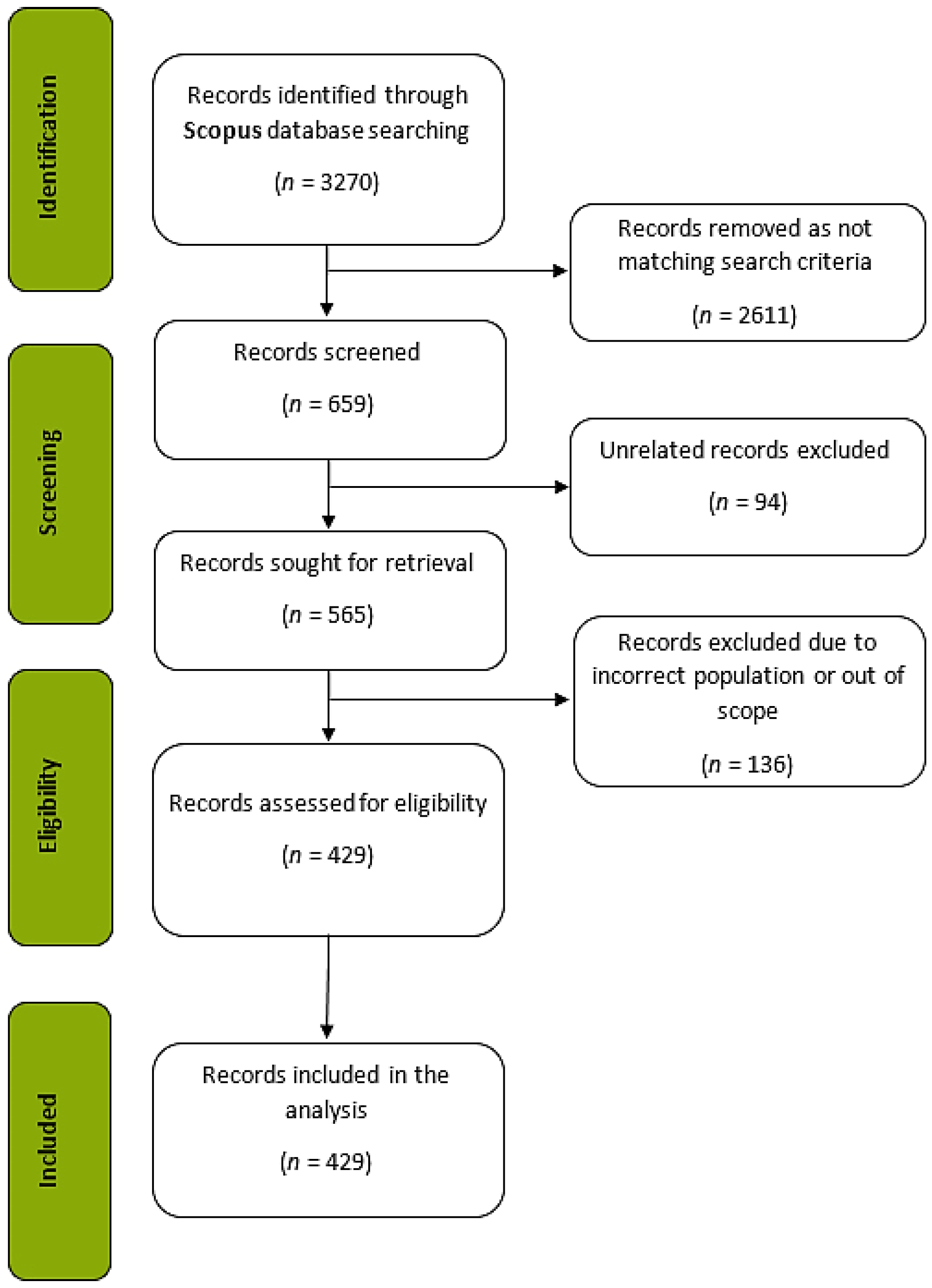
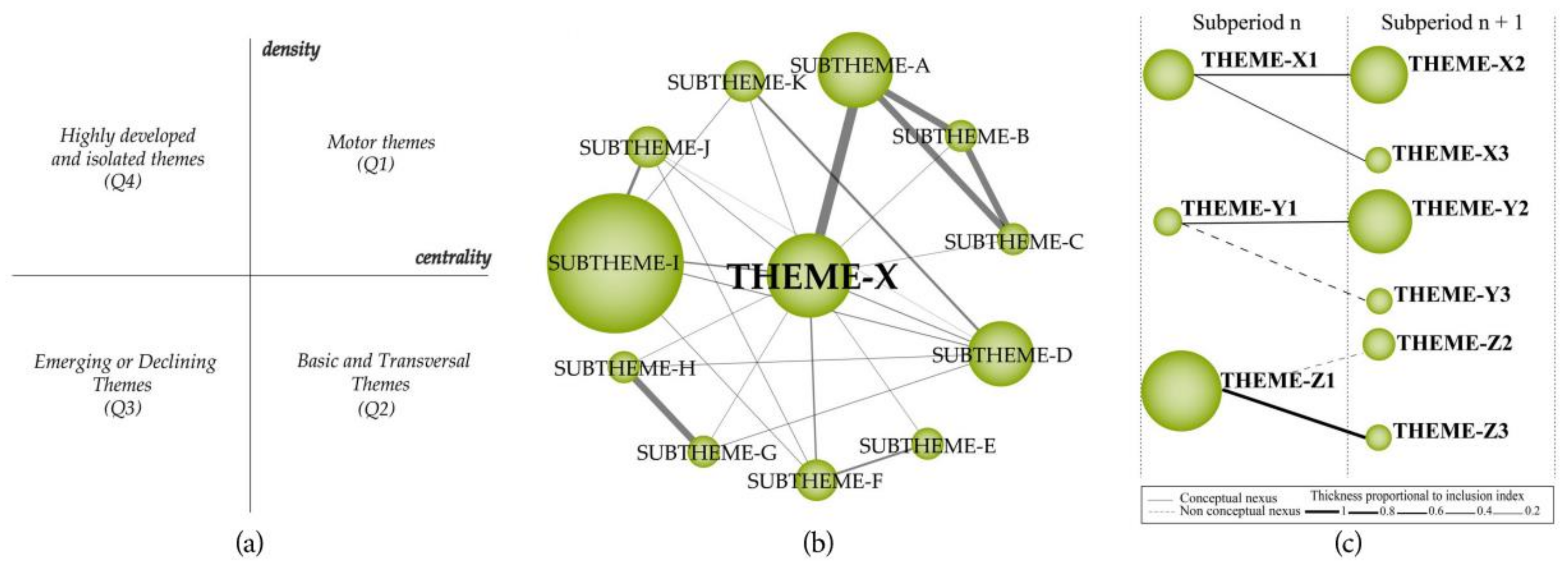
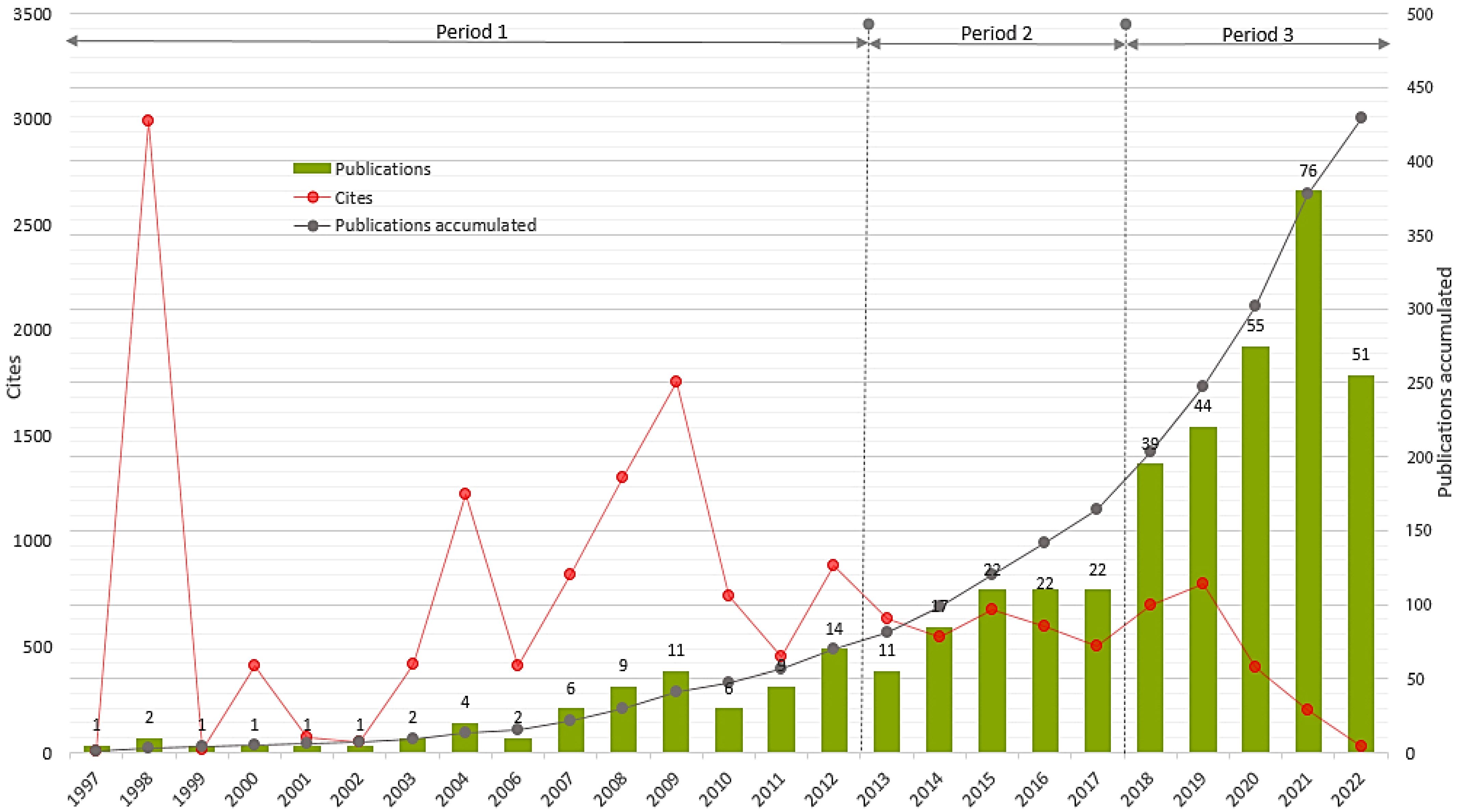
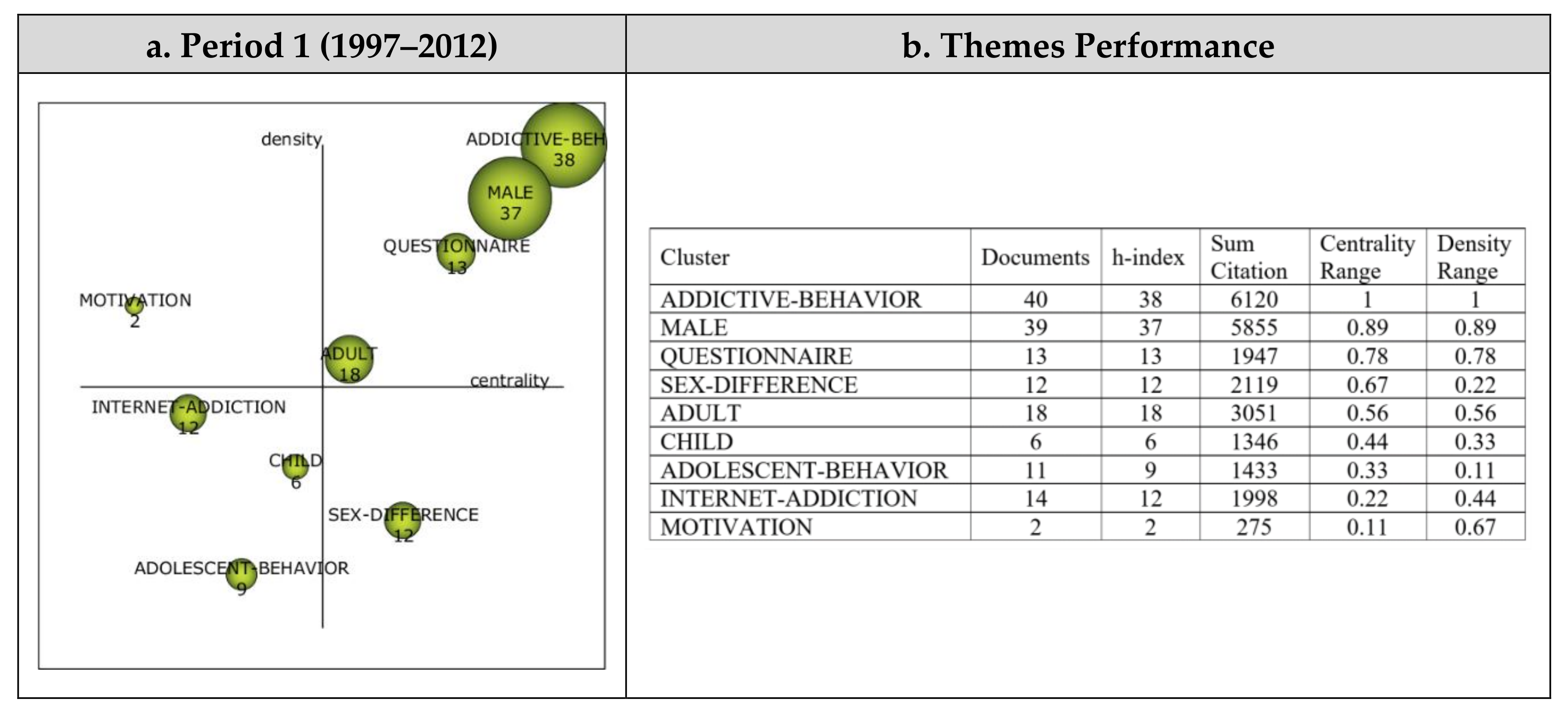
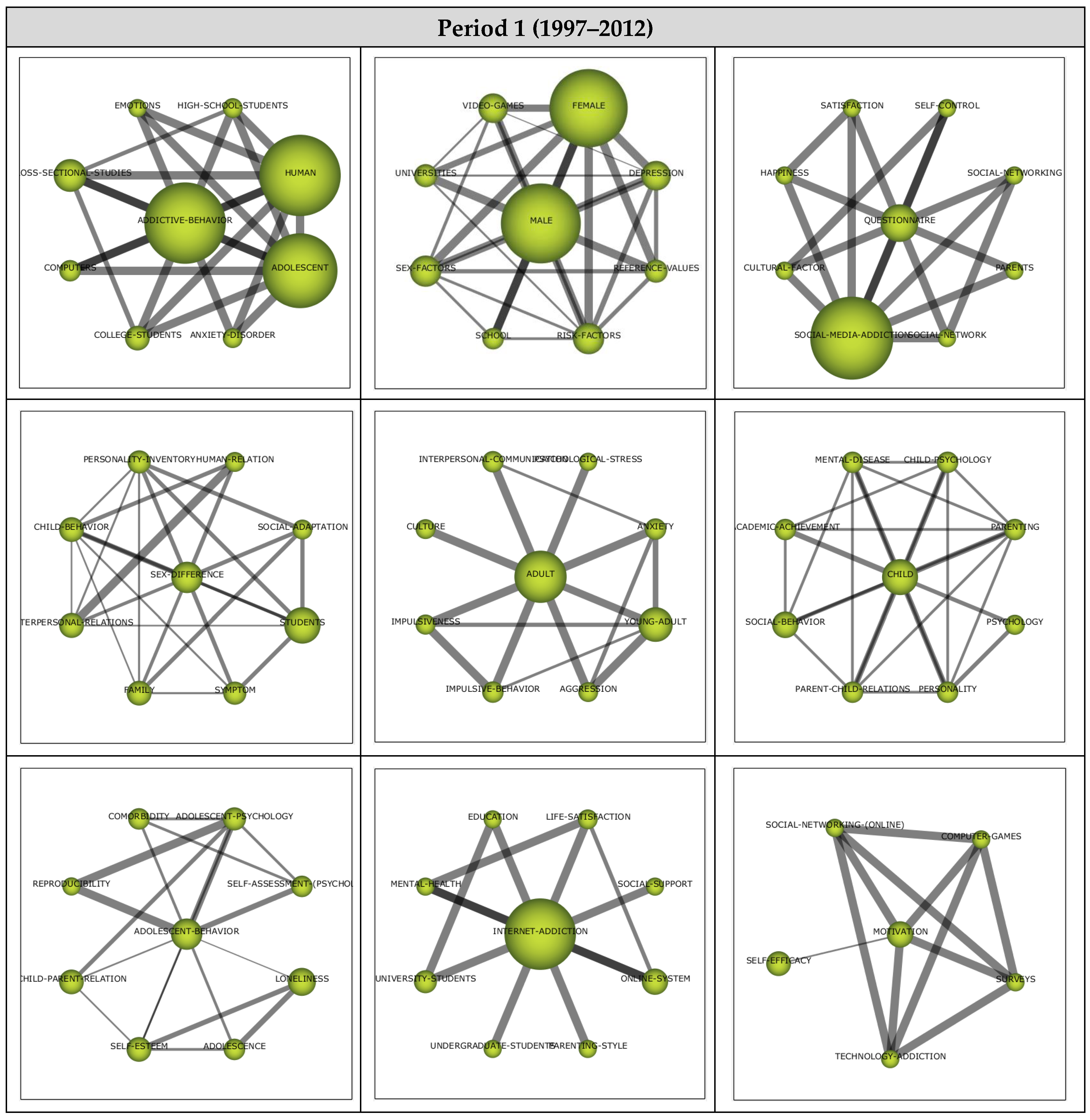
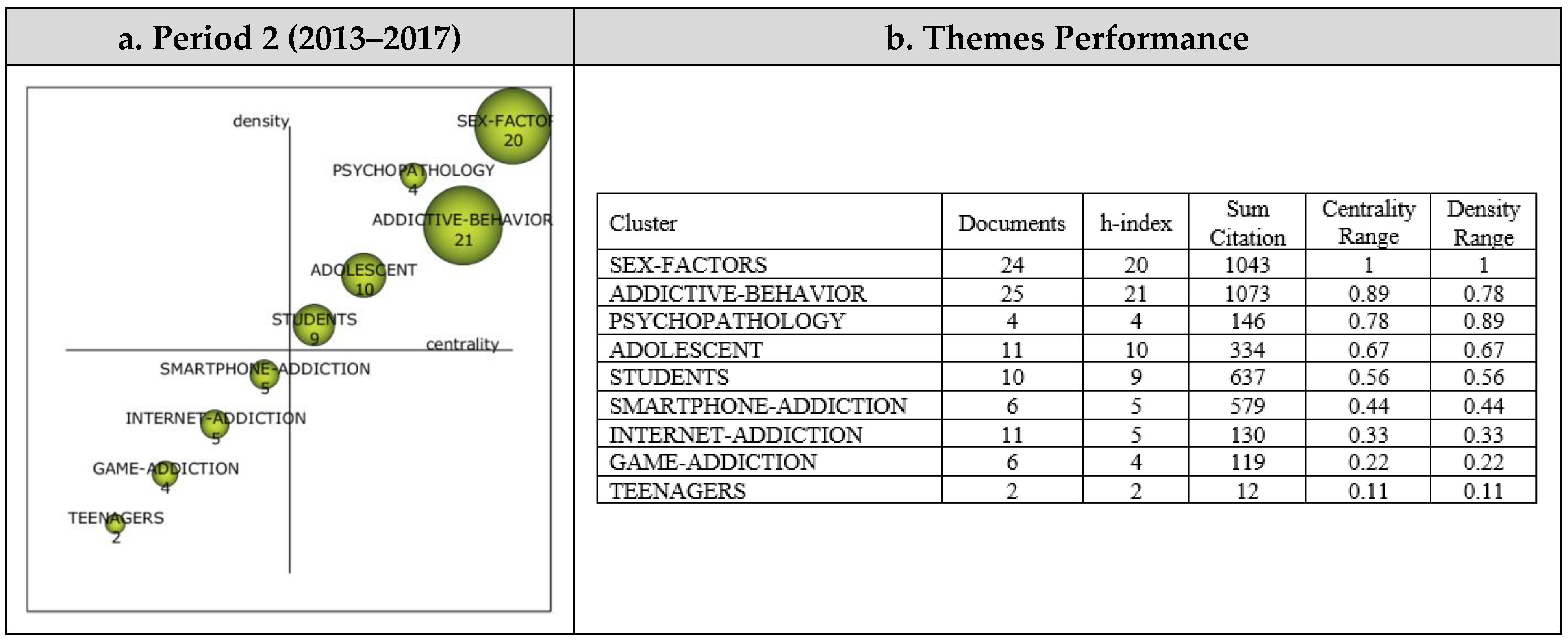
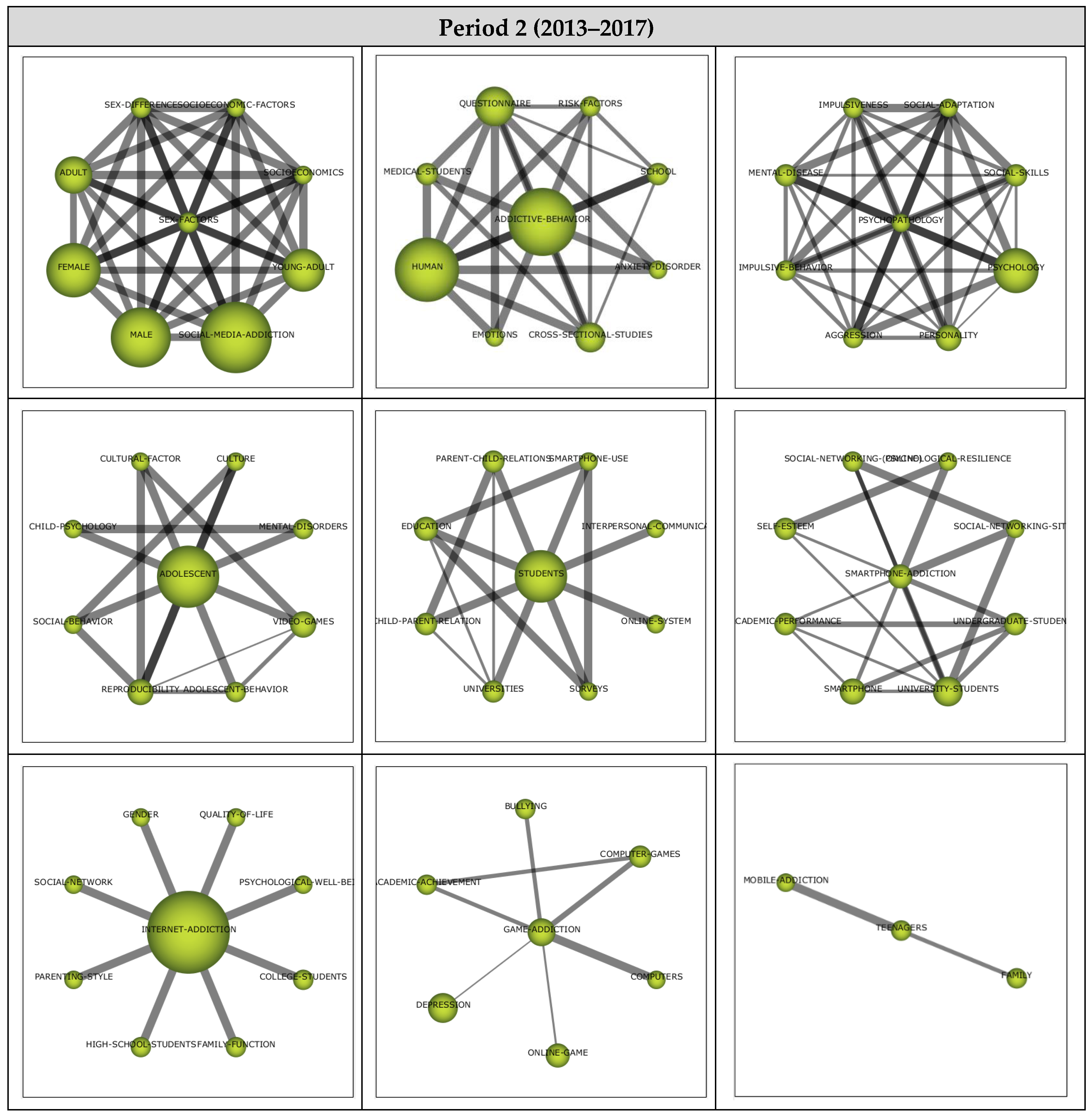
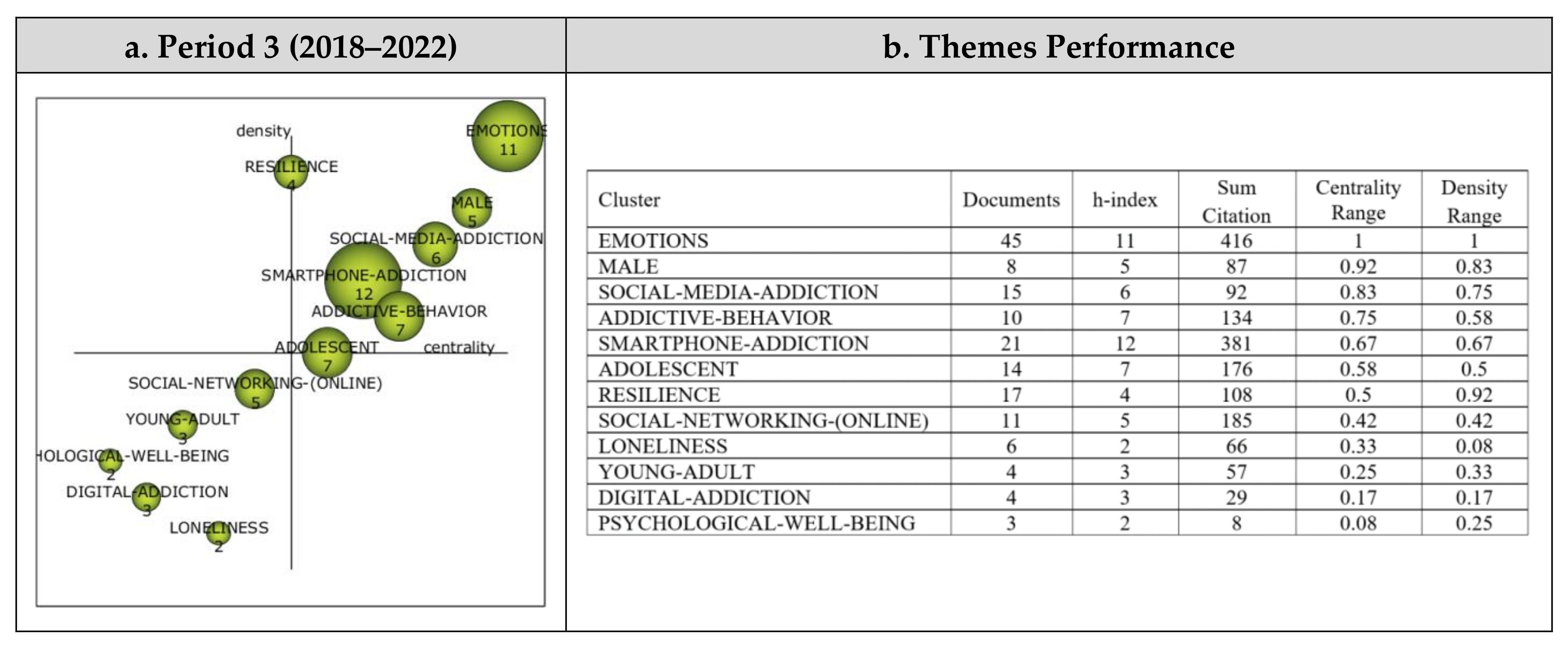
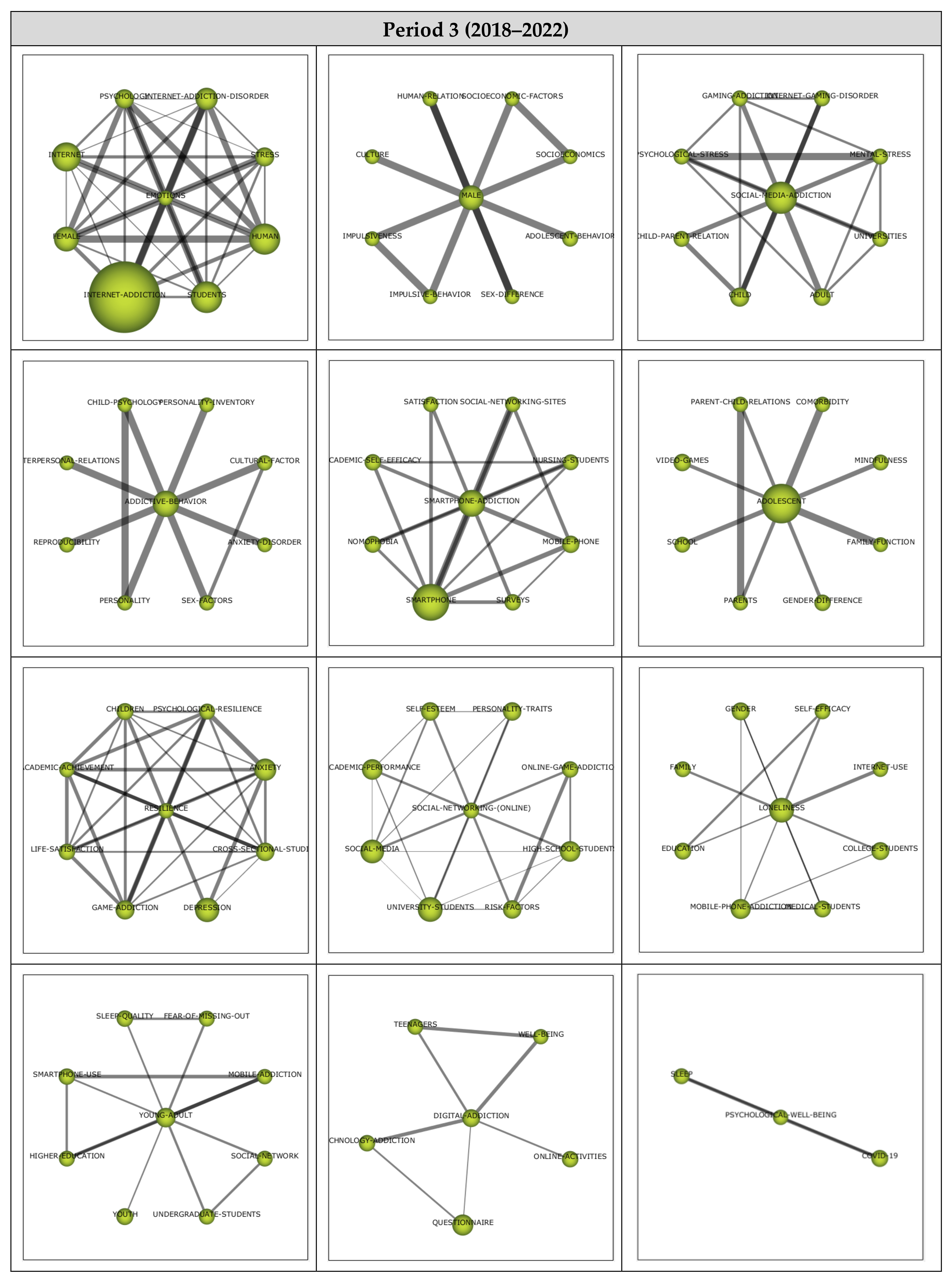
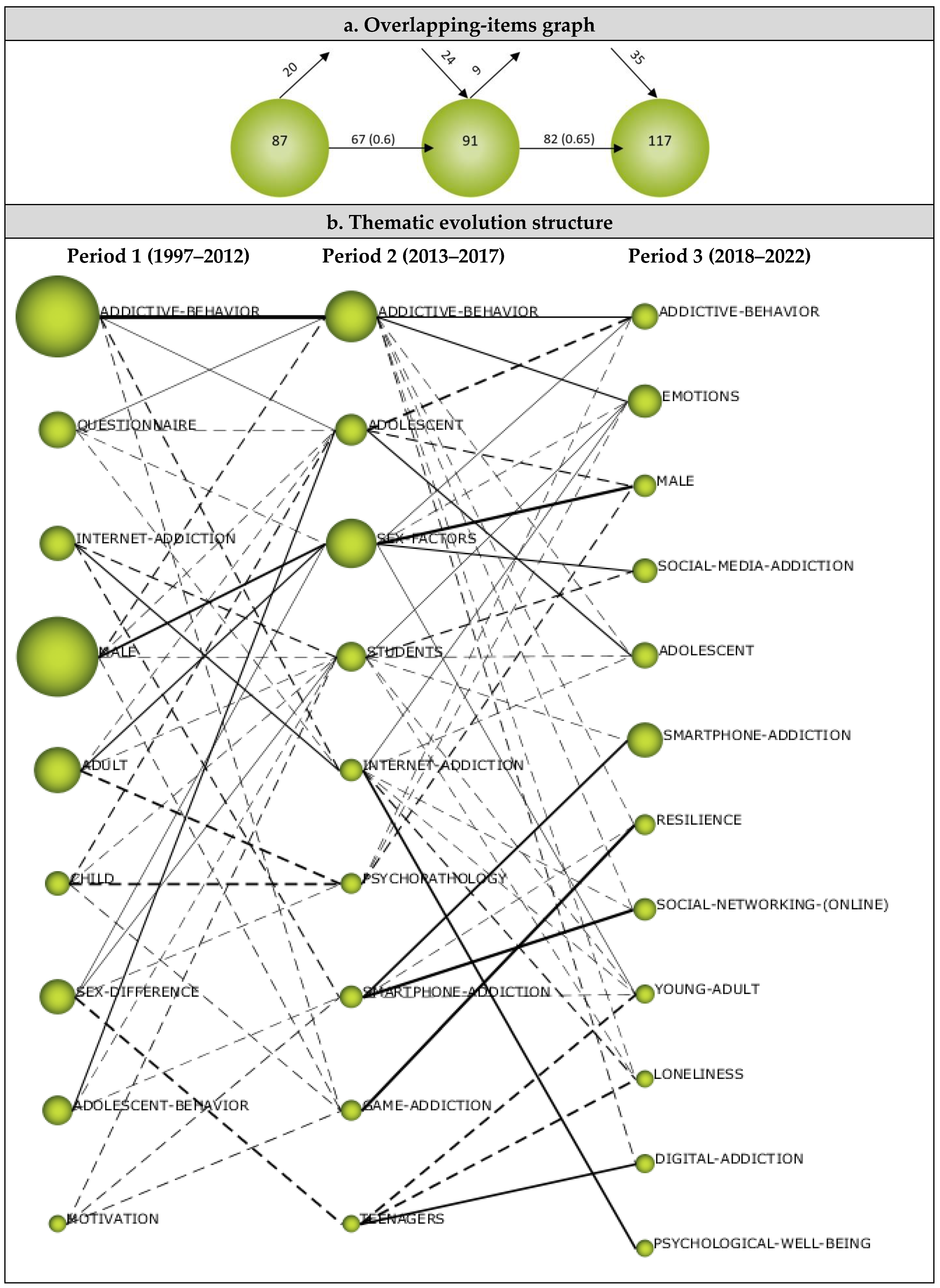
| Criteria | Included | Excluded | Rationale |
|---|---|---|---|
| Language | English | Other languages | Internationally used and researchers’ ability to understand |
| Document type | Journal articles | Books, book chapters, conference proceedings | Targeting of refereed, high-quality publications |
| Database | Scopus | Other databases (e.g., Web of Science, PubMed, etc.) | Broader coverage of journals/articles |
| Rank | Author | TC * | TP | h-İndex |
|---|---|---|---|---|
| 1 | Young, Kimberly, S. | 3219 | 5 | 29 |
| 2 | Ko, Chihhung | 1072 | 7 | 52 |
| 3 | Yen, Chengfang | 1070 | 6 | 56 |
| 4 | Yen, J. Y. | 1070 | 6 | 45 |
| 5 | Leung, Louis | 918 | 5 | 35 |
| 6 | Lemmens, Jeroen, S. | 592 | 1 | 13 |
| 7 | Peter, Jochen | 592 | 1 | 53 |
| 8 | Valkenburg, Patti, M. | 592 | 1 | 64 |
| 9 | Chen, Chengchung | 486 | 2 | 31 |
| 10 | Hawi, Nazir, S. | 483 | 5 | 14 |
| Rank | Journal Name | TP * | TC | SJR | Scopus Quartile |
|---|---|---|---|---|---|
| 1 | Cyberpsychology, Behavior, and Social Networking | 44 | 2339 | 1.15 | Q1 |
| 2 | Children and Youth Services Review | 25 | 546 | 0.80 | Q1 |
| 3 | Cyberpsychology and Behavior | 25 | 6852 | n/a | n/a |
| 4 | Turkish Online Journal of Educational Technology | 10 | 126 | n/a | n/a |
| 5 | Behavior and Information Technology | 8 | 403 | 0.70 | Q1 |
| 6 | Social Science Computer Review | 8 | 560 | 1.50 | Q1 |
| 7 | Computers and Education | 7 | 769 | 3.68 | Q1 |
| 8 | Universal Journal of Educational Research | 7 | 37 | n/a | n/a |
| 9 | International Journal of Adolescence and Youth | 7 | 57 | 0.85 | Q1 |
| 10 | Contemporary Educational Technology | 6 | 38 | 0.72 | Q1 |
| Rank | Article Name | Journal Name | Author(s) | Year | TC * |
|---|---|---|---|---|---|
| 1 | Internet addiction: The emergence of a new clinical disorder | Cyberpsychology and Behavior | Young, K. S. | 1998 | 2608 |
| 2 | Development and validation of a game addiction scale for adolescents | Media Psychology | Lemmens, J. S.; Valkenburg, P. M.; Peter, J. | 2009 | 592 |
| 3 | Internet addiction: A new clinical phenomenon and its consequences | American Behavioral Scientist | Young, K. S. | 2004 | 578 |
| 4 | Internet addiction, usage, gratification, and pleasure experience: The Taiwan college students’ case | Computers and Education | Chou, C.; Hsiao, M.-C. | 2000 | 410 |
| 5 | Shyness and locus of control as predictors of Internet addiction and Internet use | Cyberpsychology and Behavior | Chak, K.; Leung, L. | 2004 | 402 |
| 6 | Internet addiction on campus: The vulnerability of college students | Cyberpsychology and Behavior | Kandell, J. J. | 1998 | 381 |
| 7 | Online gaming addiction: The role of sensation seeking, self-control, neuroticism, aggression, state anxiety, and trait anxiety | Cyberpsychology, Behavior, and Social Networking | Mehroof, M.; Griffiths, M.D. | 2010 | 361 |
| 8 | Prevalence of Internet addiction and correlations with family factors among South Korean adolescents | Adolescence | Park, S.-K.; Kim, J.-Y.; Cho, C.-B. | 2008 | 303 |
| 9 | Factors Associated with Internet Addiction among Adolescents | Cyberpsychology and Behavior | Lam, L.-T.; Peng, Z.-W.; Mai, J.-C.; Jing, J. | 2009 | 301 |
| 10 | Family factors of Internet addiction and substance use experience in Taiwanese adolescents | Cyberpsychology and Behavior | Yen, J.-Y.; Yen C.-F.; Chen, C.-C.; Chen, S.-H.; Ko, C.-H. | 2007 | 287 |
| Rank | Country | TP * | TC |
|---|---|---|---|
| 1 | Turkey | 91 | 1420 |
| 2 | China | 55 | 2153 |
| 3 | United States | 49 | 4877 |
| 4 | South Korea | 39 | 1230 |
| 5 | Taiwan | 37 | 2962 |
| 6 | Hong Kong | 24 | 1675 |
| 7 | Russian Federation | 21 | 98 |
| 8 | Iran | 18 | 219 |
| 9 | Malaysia | 17 | 92 |
| 10 | India | 13 | 355 |
Publisher’s Note: MDPI stays neutral with regard to jurisdictional claims in published maps and institutional affiliations. |
© 2022 by the authors. Licensee MDPI, Basel, Switzerland. This article is an open access article distributed under the terms and conditions of the Creative Commons Attribution (CC BY) license (https://creativecommons.org/licenses/by/4.0/).
Share and Cite
Karakose, T.; Tülübaş, T.; Papadakis, S. Revealing the Intellectual Structure and Evolution of Digital Addiction Research: An Integrated Bibliometric and Science Mapping Approach. Int. J. Environ. Res. Public Health 2022, 19, 14883. https://doi.org/10.3390/ijerph192214883
Karakose T, Tülübaş T, Papadakis S. Revealing the Intellectual Structure and Evolution of Digital Addiction Research: An Integrated Bibliometric and Science Mapping Approach. International Journal of Environmental Research and Public Health. 2022; 19(22):14883. https://doi.org/10.3390/ijerph192214883
Chicago/Turabian StyleKarakose, Turgut, Tijen Tülübaş, and Stamatios Papadakis. 2022. "Revealing the Intellectual Structure and Evolution of Digital Addiction Research: An Integrated Bibliometric and Science Mapping Approach" International Journal of Environmental Research and Public Health 19, no. 22: 14883. https://doi.org/10.3390/ijerph192214883
APA StyleKarakose, T., Tülübaş, T., & Papadakis, S. (2022). Revealing the Intellectual Structure and Evolution of Digital Addiction Research: An Integrated Bibliometric and Science Mapping Approach. International Journal of Environmental Research and Public Health, 19(22), 14883. https://doi.org/10.3390/ijerph192214883







